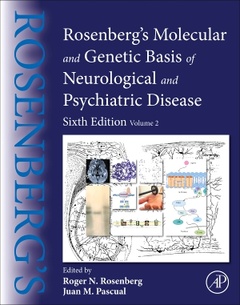Rosenberg's Molecular and Genetic Basis of Neurological and Psychiatric Disease (6th Ed.) Volume 2
Coordonnateurs : Rosenberg Roger N., Pascual Juan M.

Rosenberg?s Molecular and Genetic Basis of Neurologic and Psychiatric Disease, Sixth Edition: Volume Two provides a comprehensive introduction and reference to the foundations and practical aspects relevant to the majority of neurologic and psychiatric disease. This updated volume focuses on degenerative disorders, movement disorders, neuro-oncology, neurocutaneous disorders, epilepsy, white matter diseases, neuropathies and neuronopathies, muscle and neuromuscular junction disorders, stroke, psychiatric disease, and a neurologic gene map. A favorite of over three generations of students, clinicians and scholars, this new edition retains and expands on the informative, concise and critical tone of the first edition.
This is an essential reference for general medical practitioners, neurologists, psychiatrists, geneticists, related professionals, and for the neuroscience and neurology research community at large. The content covers all aspects essential to the practice of neurogenetics to inform clinical diagnosis, treatment and genetic counseling.
SECTION II. MOVEMENT DISORDERS
SECTION III. NEURO-ONCOLOGY
SECTION IV. NEUROCUTANEOUS DISORDERS
SECTION V. EPILEPSY
SECTION VI. WHITE MATTER DISEASESSECTION VII. NEUROPATHIES AND NEURONOPATHIES
SECTION VIII. MUSCLE AND NEUROMUSCULAR JUNCTION DISORDERS
SECTION IX. STROKE
Sub-Section: Psychiatric Disease
SECTION X. A NEUROLOGIC GENE MAP
Clinical neurologists, psychiatrists, psychologists neuroscience researchers, clinical neurology researchers, general medical practitioners, and genetic and molecular biologists with an interest in neurogenetics
He described for the first time in 1975 Machado Joseph disease, an autosomal dominant cerebellar degeneration, which produces imbalance and impaired coordination, and showed it was due to a unique expansion of DNA in the causal gene. It is the most common inherited form of impaired coordination in the world and his research has provided a genetic marker to eliminate it in large families in future generations.
He has served as the Founding Director of the UT Southwestern NIH funded Alzheimer’s Disease Center and Principal Investigator of the NIH Center Grant from 1987-2019.
He directs an active laboratory effort in Alzheimer’s Disease. He is developing a DNA Aß42 trimer vaccine for Alzheimer's disease for which he was awarded a US Patent "Amyloid Beta Gene Vaccines" in January 2009. It has been tested in mouse, transgenic mouse, New Zealand white rabbits and rhesus monkeys. The vaccine produces effective anti-Aß42 peptide antibody levels and is non-inflammatory in all three species. The vaccine reduces by 40% Aß42 peptide and by 50% tau and phospho-tau in the brains of 3X AD Tg mice, the two main pathologies of Alzheimer’s disease, with high levels of anti-Aß42 antibody and with a non-inflammatory immune response. He is preparing now a Phase 1 Clinical trial Grant - First in Hu
- Provides comprehensive coverage on the neurogenetic foundation of neurological and psychiatric disease
- Presents detailed coverage of genomics, animal models and diagnostic methods, with new coverage on evaluating patients with biochemical abnormalities or gene mutations
- Includes new chapters on the pharmacogenomics of epilepsy and the most recent updates in molecular genetics, focusing on neurodegenerative and psychiatric diseases
Date de parution : 06-2020
Ouvrage de 828 p.
21.4x27.6 cm
Thèmes de Rosenberg's Molecular and Genetic Basis of Neurological... :
Mots-clés :
?-synuclein; 5-HTTLRP; ALG14; ALG2; ATM; Acetylcholine receptor; Addiction; Aging; Agrin; Alcohol; Alzheimer’s disease; Amyloid; Amyloid precursor protein; Amyloid ß protein; Anemia; Angiogenesis; Anterior horn cell; Antipsychotic augmentation; Antipsychotic medication; Antisense oligonucleotide; Antisense oligonucleotides; Arterial dissection; Association; Ataxia; Ataxia genes; Autoimmunity; Axon; Basal ganglia (BG); Batten disease; Becker; Behavior; Behavioral variant; Bipolar disorder; Blindness; Brain morphology; Brain networks; Brain tumor; Brain volume; Brain/pathology; CAG repeat; CMT; Cardiomyopathy; Cell-cycle checkpoint; Central core disease (CCD); Cerebellar ataxia; Cerebral blood flow; Cerebrovascular disease; Channelopathy; Charcot–Marie–Tooth; Chloride channel; Choline acetyltransferase; Cholinergic interneurons (CH); Chromatin; Classification; Clinical care guidelines; Clinical trials; Coagulation; Cocaine; Cognition; ColQ; Congenital fiber type disproportion (CFTD); Congenital fiber-type disproportion (CFTD); Congenital myasthenic syndromes; Congenital myopathy (CM); Connective tissue disorders; Cortical tuber; Corticospinal tract; Cortico–striato–thalamocortical circuits (CSTC); DAPGT1; DNA damage response; DUX4; Dementia; Demyelinating disease; Depression; Desmin; Disinhibition; Distal myopathy; Dok-7; Dopamine; Dopamine (DA); Duchenne; Dysferlin; Dystrophinopathy; EEG; Early-onset dementia; Encephalopathy; Environment; Epilepsy; Epilepsy genes; Eukaryotic initiation factor-2B; Exome sequencing; Experimental therapies; Facioscapulohumeral muscular dystrophy; Familial Alzheimer’s disease; Familial hemiplegic migraine; Fasciculations; Fetal akinesia syndrome; Frontal lobes; Frontotemporal degeneration (FTD); Frontotemporal dementia (FTD)



